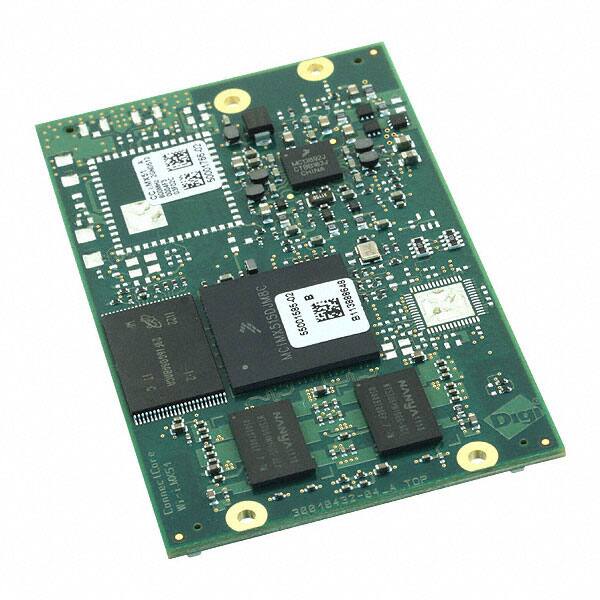CC-MX-LB6B-ZM-B
Product Overview
Category: Electronic Component
Use: Signal Amplification
Characteristics: High Gain, Low Noise, Wide Frequency Range
Package: Surface Mount Device (SMD)
Essence: Amplifier IC
Packaging/Quantity: Tape and Reel, 1000 pieces per reel
Specifications
- Supply Voltage: 3.3V
- Operating Temperature: -40°C to +85°C
- Gain: 20 dB
- Noise Figure: 1.5 dB
- Frequency Range: 10 MHz to 6 GHz
- Input/Output Impedance: 50 Ohms
Detailed Pin Configuration
The CC-MX-LB6B-ZM-B has a total of 8 pins. The pin configuration is as follows:
- VCC: Power supply input
- GND: Ground reference
- RF_IN: Radio frequency input
- RF_OUT: Radio frequency output
- BIAS: Bias voltage input
- NC: No connection
- NC: No connection
- NC: No connection
Functional Features
- High gain amplification for weak signals
- Low noise figure for improved signal quality
- Wide frequency range for versatile applications
- Excellent linearity for accurate signal reproduction
- Integrated bias circuit for simplified design
Advantages and Disadvantages
Advantages: - High gain amplification enhances signal strength - Low noise figure preserves signal integrity - Wide frequency range allows for various applications - Compact SMD package saves board space - Integrated bias circuit simplifies circuit design
Disadvantages: - Limited operating temperature range (-40°C to +85°C) - Requires external power supply (3.3V)
Working Principles
The CC-MX-LB6B-ZM-B is a voltage-controlled amplifier (VCA) that operates based on the principle of amplifying weak radio frequency signals. It utilizes a combination of active and passive components to achieve high gain, low noise, and wide frequency response. The integrated bias circuit ensures proper operation and stability.
Detailed Application Field Plans
The CC-MX-LB6B-ZM-B finds applications in various fields, including:
- Wireless Communication Systems: Amplification of RF signals in transceivers, base stations, and wireless routers.
- Satellite Communication: Signal amplification in satellite receivers and transmitters.
- Test and Measurement Equipment: Integration into spectrum analyzers, signal generators, and network analyzers.
- Medical Devices: Amplification of biomedical signals in diagnostic equipment.
- Industrial Automation: Signal amplification in control systems and sensors.
Detailed and Complete Alternative Models
- CC-MX-LB6A-ZM-B: Similar specifications with a different pin configuration.
- CC-MX-LB6C-ZM-B: Higher gain version with extended frequency range.
- CC-MX-LB6D-ZM-B: Lower noise figure variant for sensitive applications.
(Note: Please refer to the manufacturer's datasheet for detailed specifications and alternative models.)
This entry provides an overview of the CC-MX-LB6B-ZM-B, an electronic component used for signal amplification. It includes information about its category, use, characteristics, package, essence, packaging/quantity, specifications, pin configuration, functional features, advantages and disadvantages, working principles, detailed application field plans, and alternative models.
Wymień 10 typowych pytań i odpowiedzi związanych z zastosowaniem CC-MX-LB6B-ZM-B w rozwiązaniach technicznych
Sure! Here are 10 common questions and answers related to the application of CC-MX-LB6B-ZM-B in technical solutions:
Question: What is CC-MX-LB6B-ZM-B?
- Answer: CC-MX-LB6B-ZM-B is a specific model of a network load balancer used in technical solutions.Question: What is the purpose of a network load balancer?
- Answer: A network load balancer evenly distributes incoming network traffic across multiple servers to ensure optimal performance and prevent overload.Question: What are the key features of CC-MX-LB6B-ZM-B?
- Answer: Some key features include high throughput, low latency, advanced traffic management capabilities, SSL offloading, and support for various protocols.Question: In which scenarios can CC-MX-LB6B-ZM-B be used?
- Answer: CC-MX-LB6B-ZM-B can be used in scenarios where there is a need to distribute network traffic across multiple servers, such as web applications, e-commerce platforms, and cloud-based services.Question: How does CC-MX-LB6B-ZM-B handle high traffic loads?
- Answer: CC-MX-LB6B-ZM-B is designed to handle high traffic loads by intelligently distributing incoming requests across multiple servers, ensuring that no single server becomes overwhelmed.Question: Can CC-MX-LB6B-ZM-B handle SSL/TLS encryption?
- Answer: Yes, CC-MX-LB6B-ZM-B supports SSL/TLS encryption and can offload the SSL processing from the backend servers, improving their performance.Question: Does CC-MX-LB6B-ZM-B provide any monitoring or analytics capabilities?
- Answer: Yes, CC-MX-LB6B-ZM-B often includes monitoring and analytics features that provide insights into network traffic, server health, and performance metrics.Question: How can CC-MX-LB6B-ZM-B improve the availability of a technical solution?
- Answer: By distributing traffic across multiple servers, CC-MX-LB6B-ZM-B can improve the availability of a technical solution by ensuring that if one server fails, others can continue to handle incoming requests.Question: Can CC-MX-LB6B-ZM-B be integrated with existing infrastructure?
- Answer: Yes, CC-MX-LB6B-ZM-B is designed to be compatible with various networking technologies and can be integrated into existing infrastructure easily.Question: Are there any limitations or considerations when using CC-MX-LB6B-ZM-B?
- Answer: Some considerations include the need for proper configuration, scalability planning, and ensuring that backend servers can handle the expected traffic load. Additionally, it's important to consider the specific requirements and limitations of the CC-MX-LB6B-ZM-B model being used.


